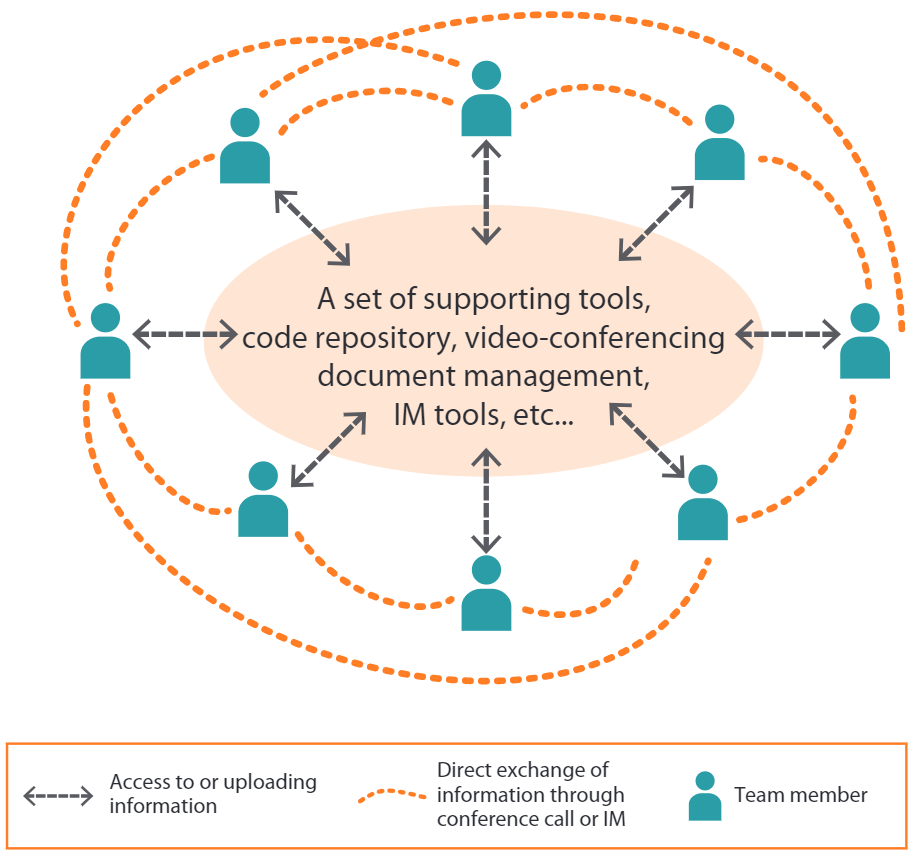Introduction
A facilitated workshop is a specialised type of meeting with:
- A clear objective in terms of deliverables.
- An owner who need the outcome of the workshop and is a driver for it to happen.
- Several participants that have relevant knowledge and are empowered to produce the deliverables.
- A fixed timeframe ("Timebox").
- A facilitator who's responsible for the process, structure and context of the event, and for enabling the group to work together to achieve the agreed goal. This person must act - and be seen to act - as independent to the project and neutral to the outcome of the workshop, while being sensitive to the needs of others, a good listener and communicator, and confident enough the challenge the assumptions of the group.
Facilitated Workshops can be used throughout the Agile Lifecycle, such as:
- At the start of the project, perhaps during Feasibility, for agreeing the direction and scope of the project, defining problems, gathering ideas, coming up with solution options, and outline planning and estimation.
- As the project progresses, for example in Foundations, for building the business case, requirements gathering and prioritisation, business or process modelling, delivery planning, risk identification, and analysis.
- During the Development phase, for Timebox or Sprint planning, resolving problems, risk mitigation planning, deployment planning, test planning, and performing reviews and retrospectives.
- During the Deployment phase, for problem resolution, increment reviews, and retrospectives
- As part of the Post-Project phase, for checking the realisation of benefits, getting user feedback, and doing retrospectives.
The main benefit of Facilitated Workshops is that they act as a catalyst for enhanced communication and much-improved decision-making, thereby providing:
- Clarity and focus about the purpose of the workshop and the required outcome.
- A quick and effective means of eliciting information
- A way of bringing people together from several business areas to allow or greater knowledge sharing and a broader perspective of the project.
- A forum for the resolution of conflict, differences of opinion, and averting ambiguity and misunderstanding
- A greater sense of involvement for the participants and their ownership of the outcome.
Organising Facilitated Workshops
1. Define and plan the workshop
As part of this discussion, they should agree:
The facilitator must engage with the workshop owner to clarify the scope and objective of the workshop.
- The form that the workshop should take, with a format that's suited to the organisation's culture and the likely participants.
- How to build in the results of previous workshops.
- The agenda, ensuring that there's sufficient time for each agenda item.
- How decisions will be made in the workshop, e.g. by consensus, unanimity, or majority voting.
- The target list of participants, based on their knowledge of the topic, skills, experience, commitment, and willingness to contribute. These people must also be empowered to make binding decisions at the workshop.
Additional thought will be needed for larger workshops, perhaps with the appointment of co-facilitators and having breakout sessions with smaller numbers of people.
2. Prepare the workshop
The facilitator or workshop owner needs to circulate information to the participants so that they can prepare themselves. This should be done well in advance and include a clear statement of the workshop’s objectives, expected outputs, agenda and attendees.
The participants must also be made aware of what will be expected of them at the workshop, the need for advance reading and for soliciting the opinions of the people or business areas they are representing.
The facilitator should secure a suitable venue and arrange logistics, refreshments and the necessary tools, such as whiteboards and flip-charts.
A scribe must also be appointed to record the emerging results of the workshop, as well as any actions, decisions and issues that will need to be progressed in its aftermath. This person must have good note-taking skills and a reasonable understanding of the topic to be able to interpret what’s being said.
3. Facilitate and run the workshop
At the start of the workshop, the facilitator should remind the attendees of the workshop’s purpose and its agenda.
It’s also good practice to outline the “ground rules” for the session, such as being on time, respecting the views of others and the need for one conversation at a time.
Once the session is underway, the facilitator should focus on driving the agenda and preventing the session from getting stuck on certain topics. Encouraging participation by all attendees and challenging the assumptions of the group is also important.
Care should be taken to avoid forcing decisions when there’s heavy resistance, perhaps by seeking consensus on the next steps.
There should be a visual recording of the workshop’s results as they emerge, with the facilitator performing checkpoints at the end of each agenda item to secure agreement around the main points before moving on. Any actions that have arisen should also be allocated to named individuals.
4. Closure
At the end of the workshop, a mini-retrospective should be held to determine whether the workshop has met its objectives, ran smoothly and ensured good participation by all. Doing this will help to improve the management of future workshops
5. Documenting the outcome
The scribe should provide notes about what was seen, discussed and agreed during the workshop, for circulation to all the participants within 48 hours. Doing this will reinforce group memory and cohesion.
These notes must include a list of actions and next steps that need to be pursued by named individuals in the days and weeks following the workshop. This list should be checked for accuracy and completeness by the facilitator and workshop owner.
6. Post-meeting
The facilitator or workshop owner must check that the actions and next steps are being progressed as expected.
Additional tips for managing remote Facilitated Workshops
The COVID-related lockdowns in 2020-21 meant that most Facilitated Workshops needed to be run remotely, which has posed other challenges for facilitators.
The following tips should be considered for the management of remote workshops:
- Keeping the workshops simple, with a self-evident process and the use of remote-friendly exercises.
- Finding the correct time zone so that workshops occur at a convenient time for the majority of the attendees.
- Providing focus by starting the workshop with a clear statement of its objectives and the process that will be followed.
- Devising additional ground rules about attendee participation and avoiding unrelated work during the workshop.
- Taking regular breaks.
- Using the most appropriate tools for:
- Video-conferencing, e.g. Teams, Zoom, Webex or Google Meet.
- Whiteboarding, e.g. Mural or Miro.
- Polling, e.g. Mentimeter, Coda or Slido.
- Knowledge sharing, e.g. Confluence or SharePoint.

These tools must be intuitive and easy to use (with minimal training), and they should be set up and tested well before the session. In addition, attendees must be made aware of which tool to use for a particular function to avoid dispersal across multiple channels.
- Advance testing of audio, video and tools by participants and their use of a quiet environment on the day, with a stable and secure internet connection.
- Getting everyone on camera to encourage their participation and involvement.
- Managing the audio so that people aren’t interrupted and to avoid the dominance of one or two individuals. The use of an instant messaging tool can help minimise noise and interruption.
- Recording the entire workshop for future reference.
Author

Agile Business Consortium
The Agile Business Consortium is the professional body for business agility. We’re all about community – whether you’re a multinational working through a large-scale transformation, a new start-up, or a contractor, we can support you to achieve more, to grow more, and to build your business agility. As a global not-for-profit organisation that’s been around for over 25 years, our knowledge and experience around agile competencies and behaviours can offer you the guidance you need to reach your agility goals. Together with our partners, we create and share agile research, case studies, resources and tools that help you compete in today’s uncertain world. A registered not-for-profit, we’re the world’s longest-standing agile-orientated organisation. We’re the brains behind AgilePM®, AgileBA®, AgilePgM®, AgilePfM™ and AgileDS™. Based in the UK, we have members in over 30 countries around the world.
Email: [email protected]
- Twitter:
- @Agile_Biz
- Website:
- www.agilebusiness.org
- LinkedIn:
- https://linkedin.com/company/agile-business-consortium



